Abstract
Accurate thickness recognition plays a vital role in safeguarding the structural reliability of critical assets. Pulse eddy current testing (PECT), as a non-destructive method that is both non-contact and insensitive to surface coatings, provides an efficient pathway for this purpose. Nevertheless, the complex, nonstationary, and nonlinear characteristics of PECT signals make it difficult for conventional models to jointly capture localized high-frequency patterns and long-range temporal dependencies, thereby constraining their prediction performance. To overcome these issues, we introduce a novel deep learning framework, multi-scale residual dilated convolution, and bidirectional long short-term memory with a squeeze-and-excitation mechanism (MRDC-BiLSE) for PECT time series analysis. The architecture integrates a multi-scale residual dilated convolution block. By combining dilated convolutions with residual connections at different scales, this block captures structural patterns across multiple temporal resolutions, leading to more comprehensive and discriminative feature extraction. Furthermore, to better exploit temporal dependencies, the BiLSTM-SE module combines bidirectional modeling with a squeeze-and-excitation mechanism, resulting in more discriminative feature representations. Experiments on experimental PECT datasets confirm that MRDC-BiLSE surpasses existing methods, showing applicability for real-world thickness recognition.
1. Introduction
Metal thickness measurement is crucial for ensuring the structural integrity of industrial components, including pipelines, aircraft structures, and pressure vessels [1,2]. Among various non-destructive testing (NDT) techniques, pulse eddy current testing (PECT) has emerged as a particularly effective method due to its non-contact measurement capability and ability to penetrate through insulation and coatings [3,4,5]. These advantages make PEC testing indispensable for continuous monitoring and quality assurance in industrial applications [6,7].
PECT operates on the principle of electromagnetic induction, whereby a pulsed magnetic field induces eddy currents in conductive materials [8,9]. A strong correlation exists between material thickness and the temporal characteristics of the resulting secondary magnetic field, specifically its decay rate [10]. The broad frequency spectrum of square-wave excitation comes from its fundamental frequency and multiple odd harmonics. These components allow the system to probe responses at different frequencies and obtain more comprehensive information about the material conditions and properties. Such properties include parameters like thickness, density, the dielectric constant, and electrical conductivity, all of which have a significant impact on signal propagation and attenuation [11,12]. However, pulse eddy current (PEC) signal processing faces significant computational challenges, as it involves handling high-dimensional time series data and modeling complex nonlinear relationships. These challenges mainly stem from the inherently non-stationary and nonlinear nature of the signals. Because their characteristics change over time and their responses do not scale linearly with the excitation, conventional linear analysis often fails to capture their behavior. As a result, accurate modeling becomes significantly more difficult [13,14]. These signals exhibit complex temporal dynamics across multiple scales, encompassing millisecond-scale decay processes that reflect eddy current diffusion through material depth and microsecond-level transient responses that encode surface information. This multi-scale characteristic presents a fundamental challenge: effective analysis techniques must capture both long-range temporal dependencies and fine-grained local dynamics without sacrificing critical information at either scale [15,16].
To address these challenges, we propose a novel multi-scale residual dilated convolution and BiLSTM-SE (MRDC-BiLSE) framework for PEC-based thickness recognition. And the proposed method is evaluated on samples with aluminium thicknesses from 20 mm to 60 mm and steel thicknesses from 5 mm to 20 mm, which reflect some conditions related to industrial inspection scenarios. Specifically, a multi-scale residual dilated convolution block (MRDC) is designed to extract diverse local features at different receptive fields, thereby enhancing the model’s capability to capture discriminative features across various temporal resolutions. To capture both local and long-range temporal dependencies, a BiLSTM-SE module is introduced, which integrates bidirectional long short-term memory (BiLSTM) with a squeeze-and-excitation (SE) module. The BiLSTM effectively models the global sequential context, while the SE module adaptively re-weights channel features to emphasize discriminative information and suppress redundancy. Finally, a regression module integrates multi-scale temporal representations to compactly represent feature maps and suppress redundancy, followed by a fully connected layer that models the nonlinear mapping from features to thickness values.
The main contributions of this paper are as follows:
- We introduce MRDC-BiLSE, a novel PECT-specific deep model that jointly exploits multi-scale residual dilated convolutions and a bidirectional-LSTM squeeze-and-excitation (BiLSTM-SE) module. This design unifies local high-frequency pattern mining with global temporal context modeling while adaptively re-weighting informative frequency channels, directly addressing the non-stationary and nonlinear nature of eddy current signals.
- The proposed framework integrates multi-scale residual dilated convolution (MRDC) for capturing features across multiple temporal resolutions and a BiLSTM-SE module for joint temporal modeling and adaptive feature re-weighting, leading to more robust and discriminative representations.
- Extensive experiments on two public PECT datasets (PEC-Aluminum and PEC-S355) demonstrate that MRDC-BiLSE surpasses nine competitive baselines—including CNN, ResNet, GRU, transformer, and TCN—achieving up to a 35.4% lower MSE and 19.1% lower MAE. Cross-validation analyses further confirm superior accuracy and stability across folds and materials.
2. Related Work
2.1. Traditional PECT Methods
Pulse eddy current testing (PECT) has established itself as a cornerstone technique in non-destructive testing (NDT) [17], particularly valued for its non-contact nature and exceptional ability to penetrate surface coatings while maintaining measurement accuracy [18]. Machine learning approaches have gained significant traction in eddy current testing applications over the past decade, though traditional methodologies continue to serve as fundamental benchmarks for evaluation. Liu et al. [19] proposed a model-free eddy current defect recognition framework that integrates SVM classification and an improved particle swarm optimization algorithm, achieving higher accuracy and efficiency than conventional classifiers. Aldbaisi et al. [20] demonstrated the use of apparent eddy current conductivity (AECC) spectroscopy combined with artificial neural networks to accurately estimate conductive coating thickness while reducing lift-off sensitivity, achieving a maximum uncertainty of only 3.37%. Sophian et al. [21] applied principal component analysis to pulsed eddy current signals to enhance defect characterization, demonstrating improved classification performance compared with conventional peak-based methods.
Conventional PECT methodologies have primarily relied on handcrafted feature extraction techniques, employing parameters such as peak amplitude, time-to-peak characteristics, and frequency-domain signatures in conjunction with shallow learning models [22,23]. A notable contribution in this domain was presented by Wen et al. [24], who proposed a frequency-domain lift-off point-of-intersection (LOI) methodology for thickness measurement applications. Their experiments were conducted on aluminium samples with a conductivity of approximately 30 MS/m using a sinusoidal excitation of 200 Hz and 5 V with lift-off distances ranging from 0.5 mm to 1.5 mm. The results demonstrated that both LOI frequency and amplitude decrease as the sample thickness increases, establishing a foundational principle for subsequent developments in PEC-based thickness evaluation. Building upon this foundation, Chen et al. [25] proposed a resistance–frequency eddy current method tailored for titanium alloy sheets with thicknesses between 0.4 mm and 1.5 mm, achieving improved linearity and accuracy over conventional impedance-based techniques.
These traditional approaches are effective in controlled environments, where the material properties are known and noise levels are low. However, they still exhibit inherent limitations in resilience and generalizability. The reliance on handcrafted features constrains their ability to effectively handle complex signal dynamics, environmental noise, and sophisticated multi-layer structural configurations. Furthermore, Wang et al. [26] investigated the intricate roles of conductivity in eddy current distributions within both isotropic and anisotropic materials, revealing the substantial complexity of signal behavior in anisotropic cases that traditional methods struggle to address adequately.
2.2. Deep Learning Approaches
Deep learning methodologies have provided transformative solutions by leveraging automated feature extraction capabilities to enhance signal modeling sophistication. Convolutional neural networks (CNNs) have gained widespread adoption for capturing spectral and spatial patterns in PEC signals. Liu et al. [27] converted one-dimensional PEC signals into time–frequency images using the Warblet transform, from which the CNN automatically extracted key features such as energy distribution and frequency variation patterns for defect classification. Chen et al. [28] used multi-frequency impedance responses as inputs, enabling the network to capture frequency-dependent spectral features for a more accurate evaluation of welding quality.
To address CNN limitations in modeling temporal dependencies, long short-term memory networks have been investigated. Yang et al. [29] proposed a CNN-LSTM hybrid model for thin-walled structure thickness assessment, effectively capturing bidirectional temporal context. Na et al. [30] provided a comprehensive analysis of machine learning developments in phased array ultrasonic NDT, emphasizing hybrid CNN-LSTM architecture efficiency.
Recent sophisticated architectures have further advanced PEC signal analysis. Bai et al. [31] introduced squeeze-and-excitation blocks within enhanced CNN-LSTM frameworks for concrete reinforcement identification, enabling dynamic feature recalibration and enhanced robustness to lift-off fluctuations. Meng et al. [32] developed real-time tunnel-magnetoresistive-based PEC systems with deep learning for industrial applications. She et al. [33] presented transformer-based architectures with self-attention mechanisms using optimized Res2Net networks for thickness measurement and surface defect detection. While these advanced approaches demonstrate considerable promise, significant challenges remain in effectively handling complex, multi-material inspection scenarios that are increasingly common in industrial applications.
3. Method
3.1. Overview
Aiming at the complex characteristics of pulsed eddy current detection (PECT) signals, such as non-stationarity, high-frequency perturbation, and long-range timing dependence in thickness identification, this paper proposes a deep learning framework, MRDC-BiLSE, which fuses multi-scale convolution, timing modeling, and channel attention in an end-to-end manner to achieve accurate prediction of thickness. In the overall architecture, a multi-scale residual dilation convolution module is first introduced for extracting local structural features at different time scales. The module effectively captures the multilevel features in the signal that contain both high-frequency details and low-frequency trends by setting multiple 1D convolution kernels with different dilation rates in parallel; at the same time, the residual linking mechanism improves the feature fusion capability and makes the model more sensitive to the response to the early thickness changes. Subsequently, the extracted multi-scale features are fed into the BiLSTM-SE module to capture global contextual relationships over long time scales. This module addresses the limitation of the convolutional structure’s limited sensory field by modeling both the forward and backward information of the time series. To further enhance the discriminative power of the features, a squeeze-and-excitation block (SE block) is embedded in the module, which adaptively adjusts the importance weights of each channel according to the global context and enhances the focus on useful signal channels. Eventually, the timing-enhanced and semantically optimized features are compressed by the adaptive average pooling layer, and the final thickness prediction results are output by the fully-connected regression layer. The flowchart of the method is shown in Figure 1.
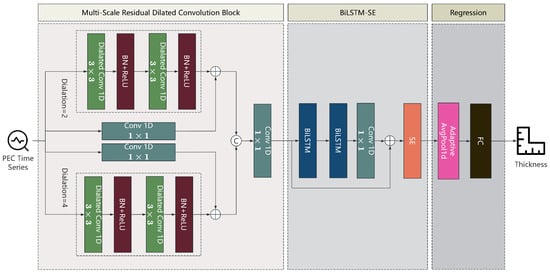
Figure 1.
Overall architecture of the proposed MRDC-BiLSE framework.
3.2. Multi-Scale Residual Dilated Convolution Block
In pulse eddy current testing (PECT) signals, high-frequency noise and local variations often coexist, making the effective extraction of discriminative features a challenging task. Traditional convolutional networks, due to their fixed receptive fields, struggle to simultaneously handle multi-scale temporal information, limiting their performance in complex signal analysis. To address this, this paper proposes the multi-scale residual dilated convolution block (MS-RDCB), which aims to enhance the model’s ability to perceive features across different time scales. The module employs two parallel dilated convolution branches, each with a different dilation rate, to enable perception of the input signal at different sampling intervals (formulated in Equations (2)–(5)). Each branch consists of multiple layers of 1D dilated convolutions, batch normalization, and an activation function, ensuring the stability and expression ability of feature extraction. To further fuse information across different scales, the module performs residual connections at the end of each branch and subsequently combines cross-scale information through feature concatenation operations(formulated in Equations (6) and (7)). Finally, a convolution converts the fused features to a feature representation for subsequent processing (formulated in Equation (8)).
Here, the pulse eddy current signal is denoted as X, which is a 1D time series.
where N denotes the length of the signal X. Each element represents the discrete amplitude measured at the i-th sampling point in the time domain.
The calculation of the MS-RDCB is shown below.
where denotes the dilated convolution block with a dilation of two and kernel size of . denotes the dilated convolution block with a dilation of four and kernel size of . denotes the feature concatenation. and represent the mean and variance of the batch data. is set to ensure numerical stability and to avoid division by zero. and are learnable coefficients that rescale and shift the normalized activations.
3.3. BiLSTM-SE
In thickness recognition from one-dimensional time series signals, it is crucial to capture both local and long-range temporal dependencies. Conventional CNNs focus on local patterns but overlook broader temporal context, while temporal CNNs model sequential dependencies but may lose sensitivity to fine-grained features. So, the proposed BiLSTM-SE module addresses this by combining bidirectional long short-term memory (LSTM) for comprehensive temporal modeling with a squeeze-and-excitation (SE) mechanism that adaptively re-weights channel features. It enhances global context understanding while preserving local detail sensitivity, improving robustness and prediction accuracy under complex conditions.
Let us take the extracted features from the multi-scale residual dilated convolution block (MS-RDCB) as the input to the BiLSTM-SE module. The input feature sequence is first processed by a stacked BiLSTM, where forward and backward layers jointly capture contextual dependencies from both the past and future, enhancing the modeling of long-range temporal correlations (shown in Equation (12)). The resulting features are then passed through a convolution for channel mixing and dimensionality adjustment, with a residual connection preserving low-level temporal cues and ensuring stable gradient flow (shown in Equation (13)). Finally, the output is refined by a squeeze-and-excitation (SE) block, which aggregates global channel information and applies learnable weights to emphasize discriminative temporal patterns while suppressing irrelevant noise (shown in Equation (14)).
The calculation of the BiLSTM-SE block can be shown below.
where represents the Bi-LSTM block and denotes the squeeze-and-excitation block. denotes the extracted features by the BiLSTM-SE block.
3.4. Regression
In the final stage of thickness prediction, directly flattening feature maps can easily introduce redundancy and noise. To address this, we employ adaptive average pooling to compress each feature map, thereby enhancing robustness. Subsequently, the pooled features are introduced into a fully connected layer to learn the nonlinear relationship from feature to target thickness values. This simple yet effective regression structure provides the network with stable and interpretable regression output capabilities.
Let us take as the input, representing the refined feature maps produced by the BiLSTM-SE module; the overall operation can be expressed as
where denotes the thickness prediction value and denotes the fully connected layers. denotes the adaptive average pooling operation.
4. Experiment
4.1. Datasets
The experimental datasets used in this study were the PEC datasets [32]. Two types of materials were tested, namely aluminium (denoted as PEC-Aluminum) and S355 (denoted as PEC-S355) mild steel. The PEC measurement system used for data acquisition was a custom-designed device based on an STM32F407VGT6 microcontroller (STMicroelectronics, Geneva, Switzerland) and a tunnel magnetoresistance (TMR) magnetic sensor supplied by a commercial manufacturer (MultiDimension Technology Co., Ltd., Zhangjiagang, China). The measurements are stored in a one-dimensional time series format. For aluminium samples, the overall thickness is determined by the number of stacked plates, ranging from 20 mm to 60 mm in increments of 5 mm. For S355 mild steel, the thickness ranges from 5 mm to 20 mm, also in 5 mm increments.
4.2. Indicators
To quantitatively evaluate the performance of the proposed method in thickness prediction, four widely used regression metrics were employed, namely the mean absolute error (MAE), mean squared error (MSE), root mean squared error (RMSE), and the coefficient of determination ().
The MAE measures the average magnitude of the absolute differences between the predicted values and the ground truth values without considering their direction. A smaller MAE indicates better predictive accuracy. It is defined as
MSE calculates the average of the squared differences between predictions and true values, penalizing larger errors more heavily. Lower MSE values reflect more accurate predictions with fewer large deviations. It is defined as:
The RMSE is the square root of the MSE, which restores the error unit to the same scale as the target variable, providing a more interpretable measure of prediction accuracy. Smaller RMSE values correspond to higher predictive performance.
The score evaluates the proportion of variance in the dependent variable that can be explained by the model:
where is the mean of the ground truth values, denotes the mean squared error between predictions and true values, and represents the variance of the ground truth. An value closer to 1 indicates stronger explanatory power of the model.
4.3. Performance Comparison
To comprehensively evaluate the effectiveness of the proposed MRDC-BiLSE model, we compared its regression performance against several representative baseline models, including a convolutional neural network (CNN) [34], a depthwise separable convolutional neural network (DepthwiseCNN) [35], a fully convolutional network (FCN) [36], a gated recurrent unit (GRU) [37], multi-layer perceptron (MLP) [38], a residual neural network (ResNet) [39], ShuffleNet [40], a temporal convolutional network (TCN) [41], and a transformer [42], on two datasets, namely PEC-Aluminum and PEC-S355. The results are summarized in Table 1 and Table 2.

Table 1.
Performance comparison of different regression models for the PEC-Aluminum dataset.

Table 2.
Performance comparison of different regression models on the PEC-S355 dataset.
On the PEC-Aluminum dataset, MRDC-BiLSE achieved the best performance with the lowest MAE (4.856), MSE (41.33), and RMSE (6.40), substantially surpassing both convolutional and sequential baselines. Compared with the transformer [42], the second-best method, MRDC-BiLSE reduced the MAE by 19.1% and MSE by 35.4%, indicating its stronger ability to capture complex temporal–spatial dependencies from eddy current signals. On the PEC-S355 dataset, MRDC-BiLSE again demonstrated superior performance, achieving an MAE of 1.293, an MSE of 3.34, and an RMSE of 1.81. These values are consistently lower than those of the CNN, ResNet, and GRU. Notably, compared with the strongest baseline TCN, our model achieved a 7.6% reduction in MAE and a 5.2% reduction in MSE, demonstrating its robustness across different material types.
In summary, the results clearly verify that MRDC-BiLSE effectively integrates multi-scale residual dilated convolution, bidirectional recurrent modeling, and channel-wise feature recalibration, thereby enabling more accurate and stable thickness recognition compared with existing deep learning baselines. Moreover, since the proposed framework learns signal–feature relationships in a data-driven manner rather than relying on material-specific assumptions, it can be adapted to different conductive materials and extended to other samples by retraining or fine-tuning the model with corresponding datasets.
4.4. Cross-Validation Distribution Analysis
To further evaluate the robustness and generalization ability of different models, we computed the score distribution across multiple folds of cross-validation and summarized the results in Figure 2 and Figure 3. The score reflects the proportion of variance in the ground truth that can be explained by the model and thus provides a reliable indicator of predictive accuracy and stability.
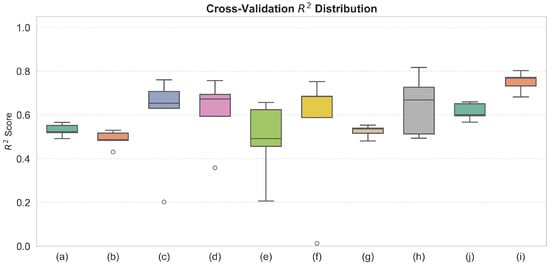
Figure 2.
Cross-validation distribution of different regression models on the PEC-Aluminum dataset. The models correspond to (a) CNN, (b) DepthwiseCNN, (c) FCN, (d) GRU, (e) MLP, (f) ResNet, (g) ShuffleNet, (h) TCN, (i) Transformer, and (j) MRDC-BiLSE.
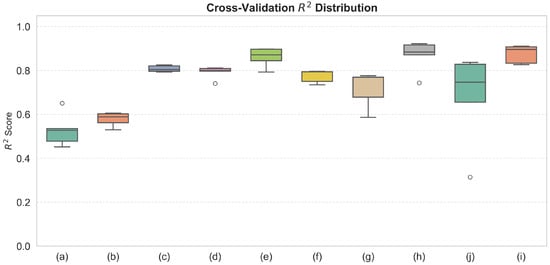
Figure 3.
Cross-validation distribution of different regression models on the PEC-S355 dataset. The models correspond to (a) CNN, (b) DepthwiseCNN, (c) FCN, (d) GRU, (e) MLP, (f) ResNet, (g) ShuffleNet, (h) TCN, (i) Transformer, and (j) MRDC-BiLSE.
For the PEC-Aluminum dataset (Figure 2), most traditional CNN-based models and shallow architectures exhibited relatively lower and more dispersed values, suggesting limited ability to capture the nonlinear and non-stationary characteristics of eddy current signals. Sequential models, such as GRURegressor, achieved moderate improvements but still suffered from higher variance across folds. In contrast, the proposed MRDC-BiLSE demonstrated consistently higher values with narrower interquartile ranges, indicating both improved explanatory power and stable generalization across different cross-validation splits. On the PEC-S355 dataset (Figure 3), the advantage of the MRDC-BiLSE became even more pronounced. While models such as the transformer and TCN performed competitively, their variance remained relatively large, reflecting instability under different training folds. In contrast, the MRDC-BiLSE achieved the highest median values while simultaneously maintaining tight distribution ranges, highlighting its ability to robustly capture both local high-frequency variations and long-range dependencies in the PECT signals.
Overall, the cross-validation analysis confirms that the proposed MRDC-BiLSE not only outperforms existing baselines in terms of average predictive accuracy but also exhibits significantly enhanced robustness and stability, which are critical for real-world deployment in non-destructive testing applications.
4.5. Residual Distribution Analysis
To further evaluate the recognition performance of the proposed MRDC-BiLSE model, we analyzed the residual distributions under different thickness values. Figure 4 and Figure 5 illustrate the density distribution of residuals.
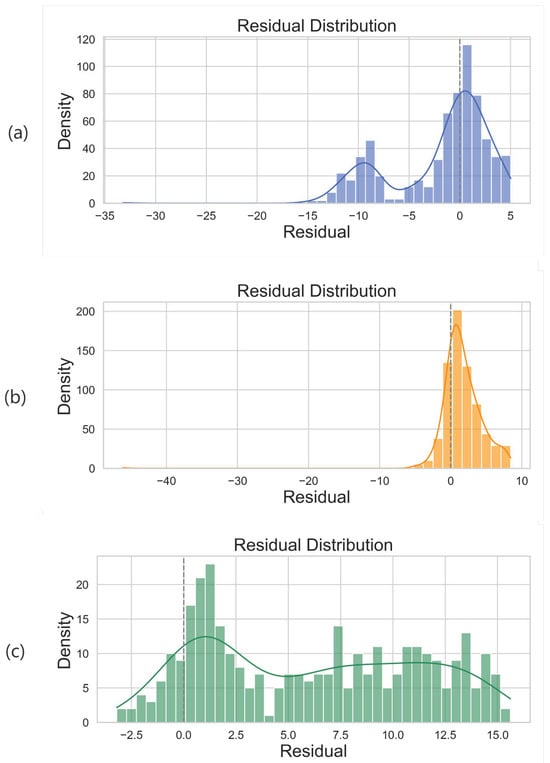
Figure 4.
Residual distribution of the MRDC-BiLSE model on the PEC-Aluminum dataset. (a) Thickness = 20 mm; (b) thickness = 30 mm; (c) thickness = 40 mm.
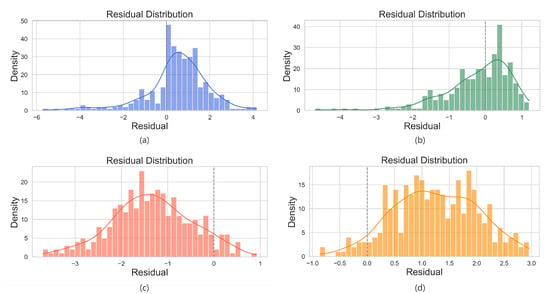
Figure 5.
Residual distribution of the MRDC-BiLSE model on the PEC-s355 dataset. (a) Thickness = 5 mm; (b) thickness = 10 mm; (c) thickness = 15 mm; (d) thickness = 20 mm.
In both datasets, the majority of residuals are concentrated around zero, with relatively narrow distributions, which indicates that the proposed model achieves stable predictions with minimal systematic bias. While certain cases exhibit slight deviations and heavier tails, these remain within an acceptable range and do not substantially affect the overall error profile. Importantly, the residual distributions do not display strong skewness or extreme outliers, suggesting that prediction errors are well-balanced and largely symmetric. These results demonstrate that the MRDC-BiLSE model maintains robust predictive performance across various material conditions and signal complexities. This consistency across datasets further highlights the strong generalization ability of the proposed framework in capturing the essential dynamics of PEC signals for reliable thickness recognition.
4.6. Comparative Analysis of Predictions and Ground Truth
To further validate the effectiveness of the proposed MRDC-BiLSE model, the predicted values were directly compared with the ground truth on two different datasets, as shown in Figure 6 and Figure 7. In these visualizations, the red dashed lines represent the true thickness values, while the scatter points correspond to the predicted outputs.
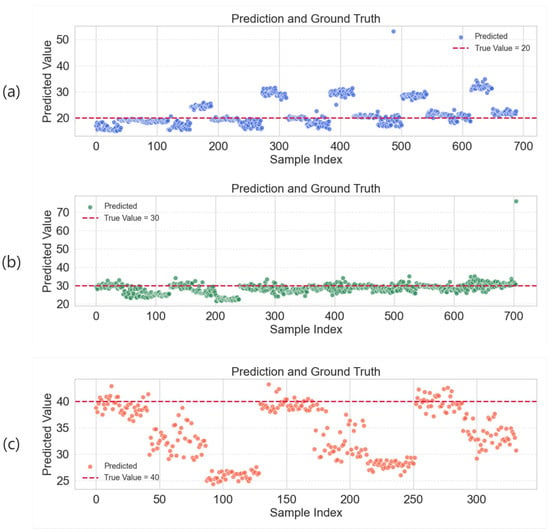
Figure 6.
Prediction and ground truth of the MRDC-BiLSE model on the PEC-Aluminum dataset. (a) Value = 20; (b) value = 30; (c) value = 40.
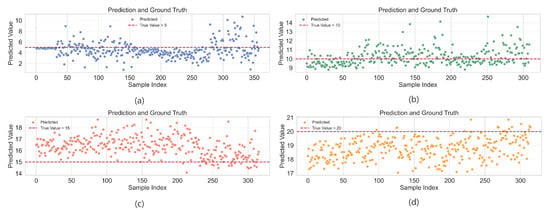
Figure 7.
Prediction and ground truth of the MRDC-BiLSE model on the PEC-s355 dataset. (a) Value = 5; (b) value = 10; (c) value = 15; (d) value = 20.
Overall, the predictions exhibit a strong alignment with the ground truth across both datasets. Most predicted values are tightly distributed around the reference lines, indicating that the model achieves accurate and stable thickness estimation without introducing systematic bias. Although a limited number of outliers and fluctuations can be observed, these deviations remain within an acceptable range and do not alter the overall prediction trend. Importantly, the prediction patterns remain consistent across datasets, which suggests that the proposed MRDC-BiLSE framework can generalize well to different conditions and signal variations. It also provides further evidence that MRDC-BiLSE delivers reliable thickness recognition and possesses strong potential for real-world non-destructive testing applications.
4.7. Ablation Study
To further verify the effectiveness of the proposed MRDC-BiLSE, we conducted ablation studies on both the PEC-Aluminum and PEC-S355 datasets, as summarized in Table 3 and Table 4. The complete MRDC-BiLSE model achieved the lowest prediction errors across all metrics. Removing the BiLSE module resulted in a substantial increase in error (e.g., RMSE rising from 6.40 to 10.17 on PEC-Aluminum and from 1.81 to 2.39 on PEC-S355), demonstrating the critical role of bidirectional temporal modeling and adaptive channel recalibration in capturing long-range dependencies and suppressing redundant features. Similarly, removing the MSRD module also caused performance degradation (RMSE increasing to 7.21 and 3.42 on PEC-Aluminum and PEC-S355, respectively), highlighting its importance for extracting local multi-scale patterns inherent in eddy current signals.

Table 3.
Ablation study results on the PEC-Aluminum dataset.

Table 4.
Ablation study results on the PEC-S355 dataset.
Beyond the average performance, we further examined cross-validation distributions to assess the effect of each module on model stability and generalization (Figure 8 and Figure 9). The complete MRDC-BiLSE (a) consistently achieved the highest median values with narrow interquartile ranges, indicating both strong explanatory power and stable generalization. In contrast, the variants without LSTMSE or MSRD exhibited noticeably lower median scores and wider spreads, reflecting reduced robustness across folds. Notably, the absence of BiLSE led to a sharp decline in stability, while the removal of MSRD resulted in larger fluctuations and performance variance, confirming their complementary roles.
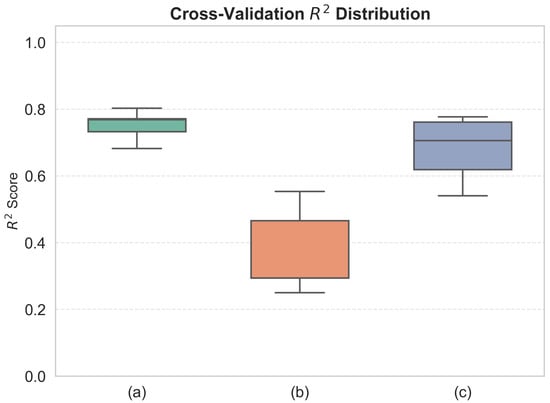
Figure 8.
Cross-validation distribution of ablation models on the PEC-Aluminum dataset. The models correspond to (a) MRDC-BiLSE, (b) MRDC-BiLSE_without_BiLSE, and (c) MRDC-BiLSE_without_MSRD.
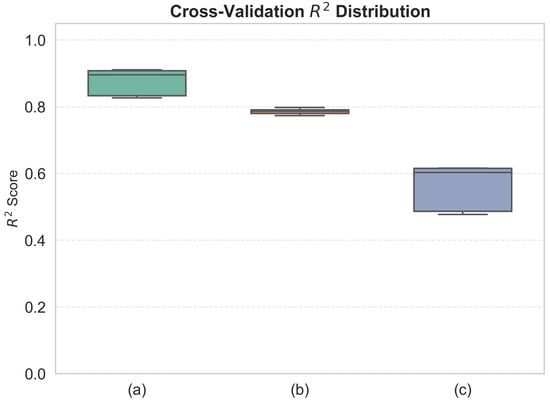
Figure 9.
Cross-validation distribution of ablation models on the PEC-S355 dataset. The models correspond to (a) MRDC-BiLSE, (b) MRDC-BiLSE_without_BiLSE, and (c) MRDC-BiLSE_without_MSRD.
Taken together, these ablation results provide clear evidence that both the BiLSE and MSRD modules are indispensable to the superior performance of MRDC-BiLSE. Their integration enables the model to simultaneously capture local multi-scale variations and global temporal dependencies, thereby ensuring both predictive accuracy and cross-fold robustness in thickness recognition tasks.
5. Discussion
In this study, we proposed a novel MRDC-BiLSE framework for thickness recognition from pulse eddy current (PECT) signals. By integrating a multi-scale residual dilated convolution (MSRD) block and BiLSTM-SE, the model is capable of simultaneously capturing local high-frequency variations and long-range temporal dependencies while adaptively enhancing discriminative feature channels. Extensive experiments conducted on two datasets demonstrate that MRDC-BiLSE consistently outperforms a wide range of state-of-the-art baselines, achieving both higher recognition accuracy and improved robustness across cross-validation folds. The superior performance can be attributed to the complementary design of MSRD and BiLSTM-SE, which jointly address the inherent non-stationarity and nonlinearity of PECT signals.
Beyond methodological contributions, the proposed framework shows strong potential for real-world industrial applications. Accurate and robust thickness recognition is crucial for assessing structural integrity in safety-critical infrastructures, including oil and gas pipelines, aircraft fuselages, and offshore platforms [43,44]. The demonstrated generalization capability across different materials highlights the feasibility of deploying the model in diverse inspection scenarios. In practical terms, such deployment can substantially reduce manual workload and improve detection efficiency. Ultimately, it contributes to enhancing the overall reliability of non-destructive testing practices.
Nevertheless, several limitations and challenges remain. First, the current experiments were conducted on datasets with limited material diversity and controlled laboratory conditions. In real-world applications, PECT signals are often affected by factors such as multi-layer protective coatings and environmental noise. These conditions may degrade recognition accuracy; thus, further validation under complex operational environments is essential. Second, the proposed MRDC-BiLSE demonstrates strong recognition accuracy; its computational complexity could limit real-time deployment on portable inspection devices or embedded systems commonly used in field inspections. Reducing the model size and improving inference speed will be critical for enabling practical on-site applications. Third, the current framework relies on fully supervised learning, which requires large-scale labeled datasets. In practice, obtaining precise thickness annotations is expensive and time-consuming, which may constrain scalability.
For future deployment in industrial scenarios, several strategies are worth pursuing. One promising direction is the development of lightweight model variants optimized for edge devices, enabling inspectors to perform real-time thickness estimation directly in the field. Another is the integration of semi-supervised or self-supervised learning paradigms, which could leverage large amounts of unlabeled inspection data to reduce reliance on manual annotation. Furthermore, incorporating adaptive calibration mechanisms would allow the system to automatically adjust to changing conditions, thereby improving robustness in diverse operational settings.
6. Conclusions
We present a novel framework for thickness recognition from PECT signals called MRDC-BiLSE. By combining multi-scale residual dilated convolution (MSRD) and bidirectional LSTM with a squeeze-and-excitation mechanism (BiLSE), the model effectively captures both local variations and long-range dependencies, addressing the nonlinear and non-stationary nature of eddy current signals. Experiments on PEC-Aluminum and PEC-S355 datasets demonstrated that MRDC-BiLSE achieves superior accuracy and robustness compared with state-of-the-art baselines. The ablation studies further verified the critical contributions of both the MSRD and LSTMSE modules, while the overall framework demonstrates strong potential for practical deployment in industrial non-destructive testing.
Author Contributions
Conceptualization: W.C., H.Z., and Y.P.; methodology: W.C., Y.P., and Z.C.; software: W.C. and B.L.; validation: S.X. and H.Y.; formal analysis: Y.P. and Z.C.; investigation: W.C. and B.L.; resources: H.Z., J.Z., and Z.C.; data curation: S.X. and H.Y.; visualization: Y.P. and B.L.; project administration: H.Z.; funding acquisition: H.Z. and Z.C.; writing—original draft: W.C. and Y.P.; writing—review & editing: H.Z., J.Z., and Z.C. All authors have read and agreed to the published version of the manuscript.
Funding
This research was supported in part by the National Natural Science Foundation of China (62071123, 61601125), the Natural Science Foundation of Fujian Province of China (2024J01971, 2020J01312).
Data Availability Statement
The PEC datasets tested for this study can be found at https://www.kaggle.com/datasets/rusuanjun/pec-dataset (accessed on 20 September 2025).
Conflicts of Interest
The authors declare no conflicts of interest.
References
- Sun, F.; Cao, B.; Fan, M.; Liu, L. Physics-based deep learning framework for Terahertz thickness measurement of thermal barrier coatings with variable refractive index. Mech. Syst. Signal Process. 2025, 228, 112430. [Google Scholar] [CrossRef]
- Tian, G.; Yang, C.; Lu, X.; Wang, Z.; Liang, Z.; Li, X. Inductance-to-digital converters (LDC) based integrative multi-parameter eddy current testing sensors for NDT&E. NDT E Int. 2023, 138, 102888. [Google Scholar]
- Gupta, M.; Khan, M.A.; Butola, R.; Singari, R.M. Advances in applications of Non-Destructive Testing (NDT): A review. Adv. Mater. Process. Technol. 2022, 8, 2286–2307. [Google Scholar] [CrossRef]
- Su, B.; Li, Y.; Liu, Z.; Wang, J.; Chen, Z. Near-and remote-field pulsed eddy current integrated testing for enhancement in imaging of buried flaws in layered conductive structures. Nondestruct. Test. Eval. 2025, 40, 3517–3530. [Google Scholar] [CrossRef]
- Fang, J.; Shen, J.; Xiong, L.; Yang, K.; Din, Z.; Meng, Z.; Yin, W.; Xiao, S. Modelling and experimental study on pipeline defect characterisations using a pulsed eddy current measurement. Nondestruct. Test. Eval. 2024, 40, 4024–4045. [Google Scholar] [CrossRef]
- Huang, P.; Pu, H.; Ding, Y.; Li, Z.; Yin, W.; Xu, L.; Xie, Y. A sensitivity enhancement PEC method for bottom flaws and corrosions detection. Measurement 2022, 202, 111910. [Google Scholar] [CrossRef]
- Saleh, S. The Development and Performance Testing of a V/f Control for Induction Motors Fed by Wavelet Modulated Power Electronic Converters. IEEE Trans. Ind. Appl. 2024, 60, 5012–5024. [Google Scholar] [CrossRef]
- Romero-Arismendi, N.O.; Olivares-Galvan, J.C.; Hernandez-Avila, J.L.; Escarela-Perez, R.; Jimenez-Mondragon, V.M.; Gonzalez-Montañez, F. Past, present, and future of new applications in utilization of eddy currents. Technologies 2024, 12, 50. [Google Scholar] [CrossRef]
- Syasko, M.; Solomenchuk, P.; Soloviev, I.; Ampilova, N. A technique for multi-parameter signal processing of an eddy-current probe for measuring the thickness of non-conductive coatings on non-magnetic electrically conductive base metals. Appl. Sci. 2023, 13, 5144. [Google Scholar] [CrossRef]
- Ge, J.; Xu, F.; Yusa, N. Experimental investigation of low-frequency and pulsed eddy current testing in thickness measurement. Nondestruct. Test. Eval. 2024, 39, 1–19. [Google Scholar] [CrossRef]
- Wang, Y.; Fan, M.; Cao, B.; Ye, B.; Wen, D. Measurement of coating thickness using lift-off point of intersection features from pulsed eddy current signals. NDT E Int. 2020, 116, 102333. [Google Scholar] [CrossRef]
- Citrin, D.S. Effects of Timing Noise on Square-Wave Optoelectronic Oscillators. Appl. Sci. 2021, 11, 12038. [Google Scholar] [CrossRef]
- Huang, X.; Wehlin, P.; Srinivasan, V.; Aromando, J.; Deng, Y. A novel data-driven auto compensation algorithm for pulsed eddy current inspection of high voltage feeder cable pipe. Nondestruct. Test. Eval. 2025, 40, 1–20. [Google Scholar] [CrossRef]
- Zhao, T.; Zhang, D.; Watson, R.; Jackson, W.; MacLeod, C.; Mohseni, E.; Dobie, G. Evaluation of pulse eddy current for autonomous airborne inspections. IEEE Sens. Lett. 2024, 8, 6009304. [Google Scholar] [CrossRef]
- Li, X.; Ban, X.; Qiao, H.; Yuan, Z.; Dai, H.N.; Yao, C.; Guo, Y.; Obaidat, M.S.; Huang, G.Q. Multi-Scale Time Series Segmentation Network Based on Eddy Current Testing for Detecting Surface Metal Defects. IEEE/CAA J. Autom. Sin. 2025, 12, 528–538. [Google Scholar] [CrossRef]
- Zheng, X.; She, S.; Xia, Z.; Xiong, L.; Zou, X.; Yu, K.; Guo, R.; Zhu, R.; Zhang, Z.; Yin, W. Analyzing the permeability distribution of multilayered specimens using pulsed eddy-current testing with multi-scale 1D-ResNet. NDT E Int. 2025, 149, 103247. [Google Scholar] [CrossRef]
- Meng, B.; Zhuang, Z.; Ma, J.; Zhao, S. Research on the detection method for feeding metallic foreign objects in coal mine crushers based on reflective pulsed eddy current testing. Appl. Sci. 2024, 14, 11704. [Google Scholar] [CrossRef]
- Zhao, G.; Huang, Y.; Zhang, W.; Wang, C.; Chen, J. Advances in high-precision displacement and thickness measurement based on eddy current sensors: A review. Measurement 2025, 243, 116410. [Google Scholar] [CrossRef]
- Liu, B.; Hou, D.; Huang, P.; Liu, B.; Tang, H.; Zhang, W.; Chen, P.; Zhang, G. An improved PSO-SVM model for online recognition defects in eddy current testing. Nondestruct. Test. Eval. 2013, 28, 367–385. [Google Scholar] [CrossRef]
- Aldbaisi, A.; Abu-Nabah, B.A.; Alkhader, M.; Jaradat, M.A. Eddy current conductive coating layer assessment on conductive substrate: A machine learning approach. Nondestruct. Test. Eval. 2024, 39, 1–30. [Google Scholar] [CrossRef]
- Sophian, A.; Tian, G.Y.; Taylor, D.; Rudlin, J. A feature extraction technique based on principal component analysis for pulsed Eddy current NDT. NDT E Int. 2003, 36, 37–41. [Google Scholar] [CrossRef]
- García-Martín, J.; Gómez-Gil, J.; Vázquez-Sánchez, E. Non-destructive techniques based on eddy current testing. Sensors 2011, 11, 2525–2565. [Google Scholar] [CrossRef] [PubMed]
- Rifai, D.; Abdalla, A.N.; Ali, K.; Razali, R. Giant magnetoresistance sensors: A review on structures and non-destructive eddy current testing applications. Sensors 2016, 16, 298. [Google Scholar] [CrossRef] [PubMed]
- Wen, D.; Fan, M.; Cao, B.; Ye, B.; Tian, G. Lift-off point of intersection in spectral pulsed eddy current signals for thickness measurement. IEEE Sens. Lett. 2018, 2, 7000404. [Google Scholar] [CrossRef]
- Chen, W.; Wu, D. Thickness measurement of titanium-alloy sheets based on the resistance-frequency eddy current method. IEEE Trans. Ind. Electron. 2024, 71, 16814–16822. [Google Scholar] [CrossRef]
- Wang, S.; Zeng, Z.; Liao, Y.; Cao, Z. The roles of conductivity in eddy current distributions in nondestructive testing of isotropic and anisotropic materials. Nondestruct. Test. Eval. 2025, 40, 1–16. [Google Scholar] [CrossRef]
- Liu, B.; He, J.; Yuan, X.; Hu, H.; Zeng, X.; Zhu, Z.; Peng, J. Intelligent Defect Identification Based on PECT Signals and an Optimized Two-Dimensional Deep Convolutional Network. Complexity 2020, 2020, 9518945. [Google Scholar] [CrossRef]
- Chen, J.; Yu, N.; Fan, M.; Cao, B.; Sun, F.; Li, C. Multi-frequency eddy current non-destructive evaluation of battery tab welding quality. Nondestruct. Test. Eval. 2025, 40, 1–23. [Google Scholar] [CrossRef]
- Yang, L.; Zhao, J.; Chang, L.; Zhao, J.; Cheng, J. Evaluating the thickness of thin-walled structures from ultrasound signals based on CNN-BILSTM model. Nondestruct. Test. Eval. 2025, 40, 1–19. [Google Scholar] [CrossRef]
- Na, Y.; He, Y.; Deng, B.; Lu, X.; Wang, H.; Wang, L.; Cao, Y. Advances of Machine Learning in Phased Array Ultrasonic Non-Destructive Testing: A Review. AI 2025, 6, 124. [Google Scholar] [CrossRef]
- Bai, X.; Zhang, R.; Le, J.; Li, B.; Fu, W.; Jia, S.; Yin, W. An Intelligent Algorithm Based on the Improved CNN-LSTM for the Detection of Concrete Reinforcement Information. Prog. Electromagn. Res. M 2024, 130, 49–61. [Google Scholar] [CrossRef]
- Meng, T.; Xiong, L.; Zheng, X.; Tao, Y.; Yin, W. Real-time tunnel-magnetoresistive-based pulsed eddy current testing with deep learning. IEEE Sens. J. 2024, 24, 15540–15550. [Google Scholar] [CrossRef]
- She, S.; Zheng, X.; Xiong, L.; Meng, T.; Zhang, Z.; Shao, Y.; Yin, W.; Shen, J.; He, Y. Thickness measurement and surface-defect detection for metal plate using pulsed eddy current testing and optimized Res2Net network. IEEE Trans. Instrum. Meas. 2024, 73, 2530313. [Google Scholar] [CrossRef]
- Chauhan, R.; Ghanshala, K.K.; Joshi, R.C. Convolutional neural network (CNN) for image detection and recognition. In Proceedings of the 2018 First International Conference on Secure Cyber Computing and Communication (ICSCCC), Jalandhar, India, 15–17 December 2018; pp. 278–282. [Google Scholar]
- Howard, A.G.; Zhu, M.; Chen, B.; Kalenichenko, D.; Wang, W.; Weyand, T.; Andreetto, M.; Adam, H. Mobilenets: Efficient convolutional neural networks for mobile vision applications. arXiv 2017, arXiv:1704.04861. [Google Scholar] [CrossRef]
- Long, J.; Shelhamer, E.; Darrell, T. Fully convolutional networks for semantic segmentation. In Proceedings of the IEEE Conference on Computer Vision and Pattern Recognition, Boston, MA, USA, 7–12 June 2015; pp. 3431–3440. [Google Scholar]
- Cho, K.; Van Merriënboer, B.; Gulcehre, C.; Bahdanau, D.; Bougares, F.; Schwenk, H.; Bengio, Y. Learning phrase representations using RNN encoder-decoder for statistical machine translation. arXiv 2014, arXiv:1406.1078. [Google Scholar] [CrossRef]
- Purwins, H.; Barak, B.; Nagi, A.; Engel, R.; Höckele, U.; Kyek, A.; Cherla, S.; Lenz, B.; Pfeifer, G.; Weinzierl, K. Regression methods for virtual metrology of layer thickness in chemical vapor deposition. IEEE/ASME Trans. Mechatron. 2013, 19, 1–8. [Google Scholar] [CrossRef]
- He, K.; Zhang, X.; Ren, S.; Sun, J. Deep residual learning for image recognition. In Proceedings of the IEEE Conference on Computer Vision and Pattern Recognition, Las Vegas, NV, USA, 27–30 June 2016; pp. 770–778. [Google Scholar]
- Zhang, X.; Zhou, X.; Lin, M.; Sun, J. Shufflenet: An extremely efficient convolutional neural network for mobile devices. In Proceedings of the IEEE Conference on Computer Vision and Pattern Recognition, Salt Lake City, UT, USA, 18–22 June 2018; pp. 6848–6856. [Google Scholar]
- Bai, S.; Kolter, J.Z.; Koltun, V. An empirical evaluation of generic convolutional and recurrent networks for sequence modeling. arXiv 2018, arXiv:1803.01271. [Google Scholar] [CrossRef]
- Vaswani, A.; Shazeer, N.; Parmar, N.; Uszkoreit, J.; Jones, L.; Gomez, A.N.; Kaiser, Ł.; Polosukhin, I. Attention is all you need. Adv. Neural Inf. Process. Syst. 2017, 30. Available online: https://proceedings.neurips.cc/paper_files/paper/2017/file/3f5ee243547dee91fbd053c1c4a845aa-Paper.pdf (accessed on 20 September 2025).
- Abdollahi-Mamoudan, F.; Ibarra-Castanedo, C.; Maldague, X.P. Non-Destructive Testing and Evaluation of Hybrid and Advanced Structures: A Comprehensive Review of Methods, Applications, and Emerging Trends. Sensors 2025, 25, 3635. [Google Scholar] [CrossRef]
- Nicholls-Lee, R.; Thies, P.; Dulieu-Barton, J.M.; Olafsson, G.; Hughes, R.; Arroyo, A.H.; Xu, G.; Cartlidge, N. Non-destructive examination (NDE) methods for dynamic subsea cables for offshore renewable energy. Prog. Energy 2022, 4, 042011. [Google Scholar] [CrossRef]
Disclaimer/Publisher’s Note: The statements, opinions and data contained in all publications are solely those of the individual author(s) and contributor(s) and not of MDPI and/or the editor(s). MDPI and/or the editor(s) disclaim responsibility for any injury to people or property resulting from any ideas, methods, instructions or products referred to in the content. |
© 2025 by the authors. Licensee MDPI, Basel, Switzerland. This article is an open access article distributed under the terms and conditions of the Creative Commons Attribution (CC BY) license (https://creativecommons.org/licenses/by/4.0/).